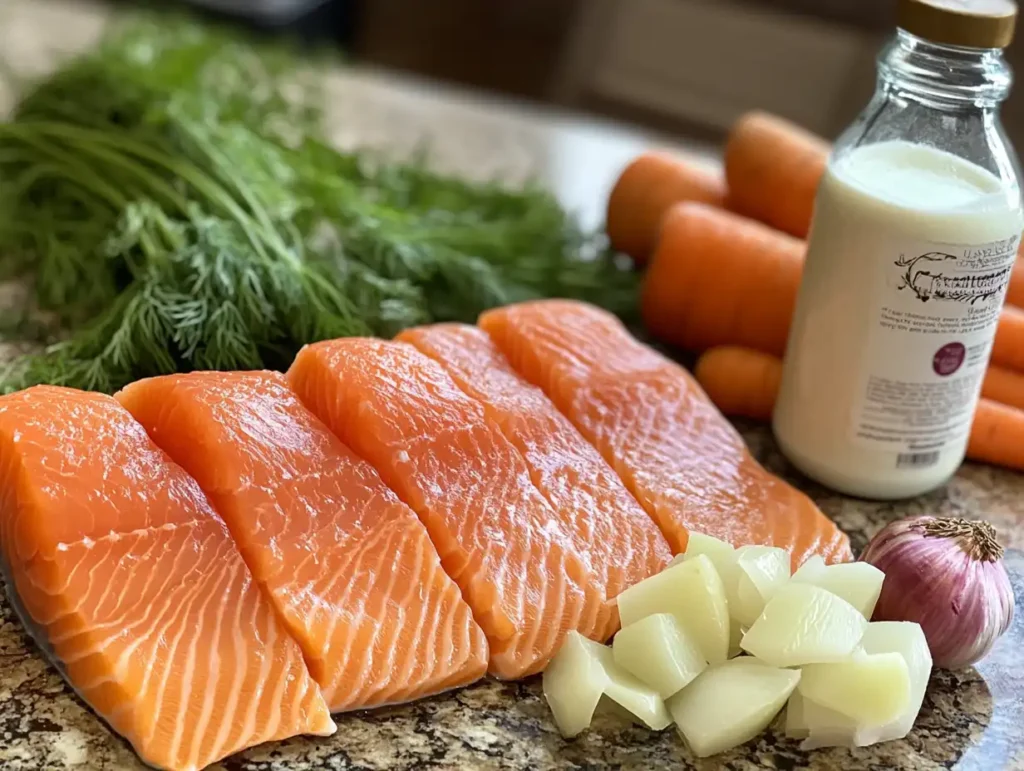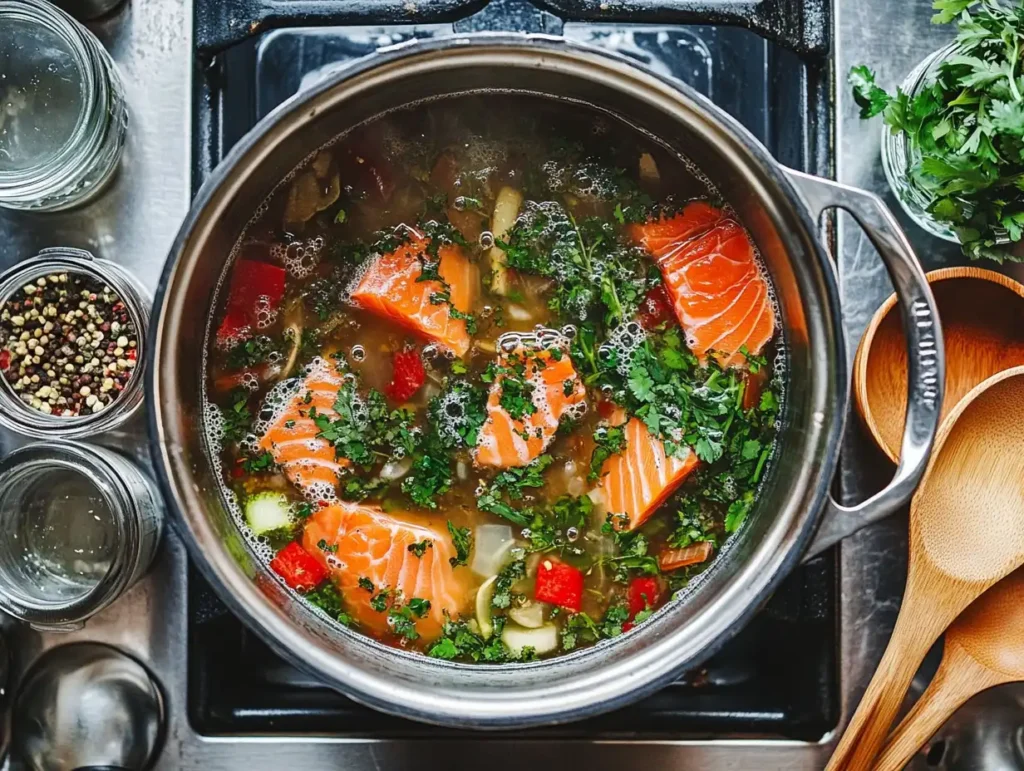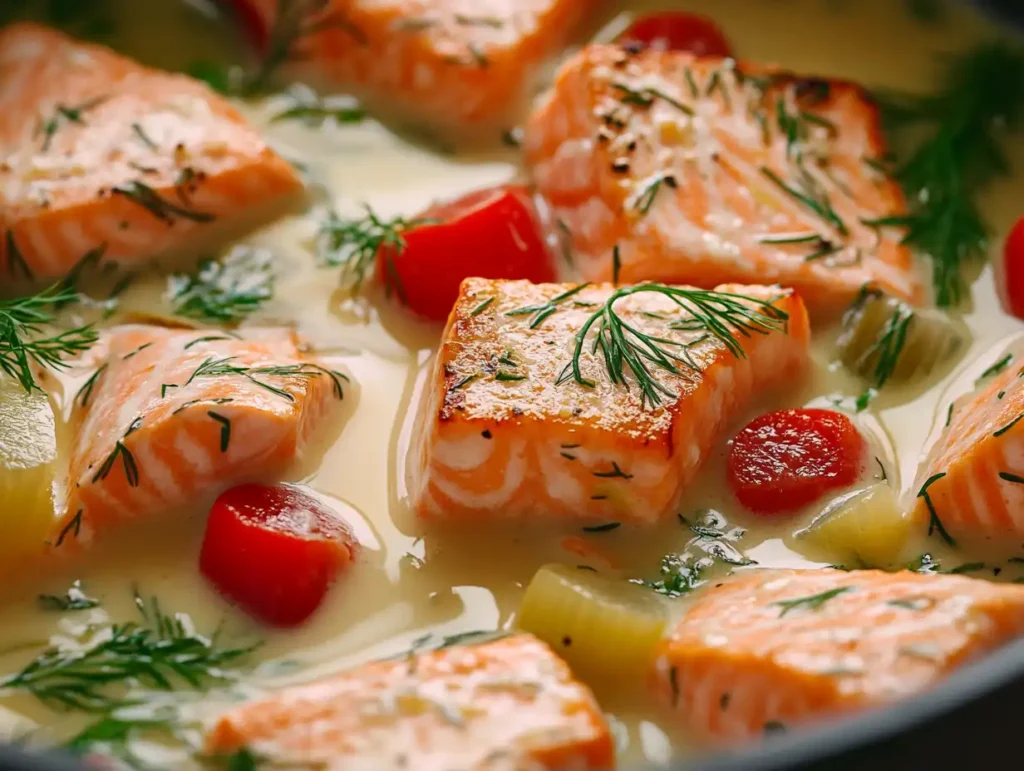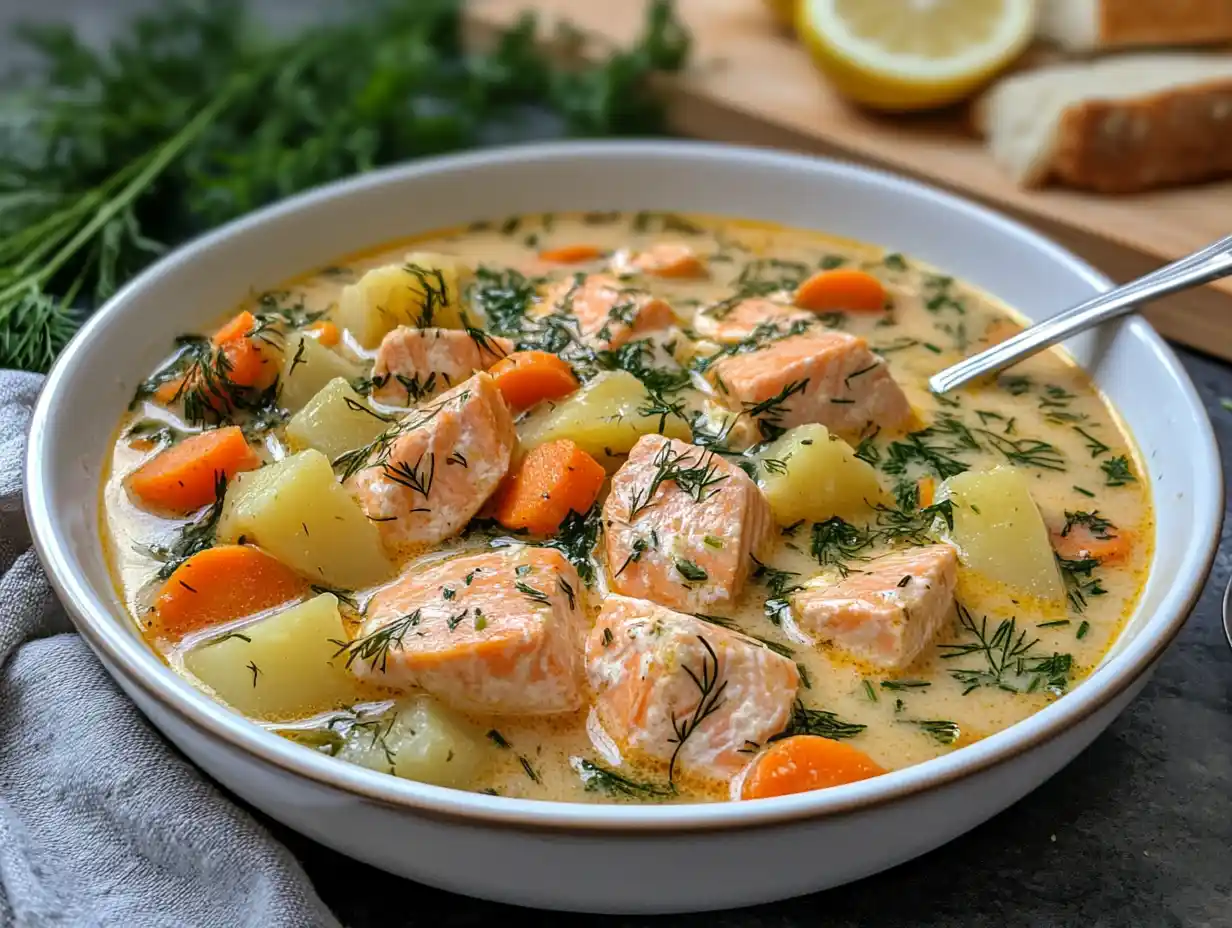Introduction
Salmon soup is a hearty and nutritious dish enjoyed in many cultures around the world. Known for its rich flavor and healthy ingredients, this soup combines salmon, vegetables, and flavorful broths to create a comforting meal that’s perfect for any season.
But what is salmon soup made of? At its core, traditional salmon soup includes fresh salmon, a savory broth, and a variety of vegetables. Depending on the recipe, it can also feature cream, herbs, grains, or even exotic flavors like miso or coconut milk for an international twist.
In this article, we’ll explore the essential ingredients in salmon soup, discuss regional variations, and provide tips on how to customize the dish to suit your preferences. Whether you’re looking for a simple weeknight meal or an elegant dinner option, salmon soup offers endless possibilities for flavor and nutrition.
Ingredients for Traditional Salmon Soup

Key Ingredients in Classic Salmon Soup Recipes
The base ingredients for most salmon soup recipes include:
- Salmon Fillets or Steaks – The star ingredient, rich in protein and omega-3 fatty acids.
- Broth or Stock – Usually fish stock or vegetable broth, forming the flavorful foundation.
- Potatoes – Adds heft and texture to the soup, making it more filling.
- Carrots – Provides a sweet balance to the savory flavors.
- Celery – Offers a subtle, aromatic flavor.
- Onions or Leeks – Adds depth and sweetness to the broth.
- Cream or Milk – Used in creamy versions for a rich, velvety finish.
- Dill or Parsley – Fresh herbs that enhance aroma and freshness.
- Lemon Juice – Brightens the flavor and complements the richness of the salmon.
Variations Based on Regional Recipes
Different cultures have put their own spin on salmon soup:
- Finnish Lohikeitto – Features salmon, cream, potatoes, carrots, and dill in a rich, creamy broth.
- Asian-Inspired Salmon Soup – Uses miso paste, soy sauce, bok choy, and mushrooms for a lighter, umami-packed version.
- Mediterranean Salmon Soup – Includes tomatoes, olives, garlic, and basil, often served with crusty bread.
Optional Ingredients for Customization
Salmon soup can be customized with additional ingredients:
- Leafy Greens – Spinach, kale, or chard for added vitamins.
- Grains and Pasta – Rice, barley, or orzo to make the soup heartier.
- Spices – Paprika, cayenne pepper, or turmeric for bold flavors.
- Seafood Additions – Shrimp, clams, or mussels for a seafood medley.
Types of Salmon Used in Soup
Fresh vs. Frozen Salmon – Which is Better?
When it comes to making salmon soup, both fresh and frozen salmon can work well, depending on availability and preference.
- Fresh Salmon – Ideal for flavor and texture, fresh salmon provides a tender bite and works best in recipes where the fish is the star. However, it’s more perishable and may require immediate use.
- Frozen Salmon – A more convenient and budget-friendly option, frozen salmon can be just as nutritious if properly thawed. Always defrost it in the refrigerator overnight for the best texture.
Best Cuts of Salmon for Soup (Fillets, Steaks, or Trimmings)
The cut of salmon you choose impacts flavor and texture:
- Fillets – Boneless and skinless fillets are the easiest to work with and provide a smooth texture.
- Steaks – Bone-in salmon steaks can add depth to the broth but may require additional effort to remove bones before serving.
- Trimmings – Heads, tails, and bones are often used to make fish stock, adding rich flavor to the soup base.
Substitutes for Salmon in Soup Recipes
If salmon isn’t available, you can use other fish options like cod, haddock, or trout. These varieties also offer a mild flavor and firm texture, making them suitable substitutes in most recipes. For vegetarian options, consider using tofu or mushrooms for protein and texture.
Broth and Base Preparation

Creating a Flavorful Fish Broth for Salmon Soup
A great salmon soup starts with a rich and flavorful broth. If making homemade broth:
- Use Fish Bones or Heads – Simmer them with onions, celery, carrots, garlic, and herbs for 30–40 minutes.
- Strain the Broth – Remove bones and vegetables, leaving a clear, flavorful base.
- Add Seasonings – Salt, pepper, bay leaves, and dill enhance the flavor.
For a quicker option, use store-bought fish stock or vegetable broth as a base.
Cream-Based vs. Clear Broth Options
- Cream-Based Broth – Creamy soups use heavy cream or milk for a rich, velvety texture. Popular in Scandinavian and Finnish recipes, this version pairs well with potatoes and carrots.
- Clear Broth – Lighter and often lower in calories, clear broths rely on herbs, lemon, and aromatic vegetables for flavor. This style is common in Asian and Mediterranean-inspired recipes.
Herbs and Spices for Enhancing Flavor
Herbs and spices add layers of flavor to the soup. Common options include:
- Fresh Dill – Provides a mild, citrus-like aroma perfect for fish dishes.
- Parsley – Adds freshness and balances flavors.
- Bay Leaves – Imparts a subtle earthy flavor to the broth.
- Garlic and Onion Powder – Enhance depth and aroma.
- Lemon Zest or Juice – Brightens the flavor, complementing the richness of the salmon.
Vegetables and Add-Ins for Salmon Soup
Common Vegetables (Potatoes, Carrots, Celery, etc.)
Vegetables play a key role in enhancing the texture, flavor, and nutrition of salmon soup. The most commonly used vegetables include:
- Potatoes – Adds heartiness and makes the soup more filling. Cubed or diced potatoes absorb the flavors of the broth beautifully.
- Carrots – Brings a natural sweetness and vibrant color to the soup. Slice them thin for quick cooking.
- Celery – Provides a savory, aromatic base that complements the broth and salmon.
- Onions and Leeks – Offer sweetness and depth, creating a more flavorful base.
- Garlic – Enhances the aroma and blends well with herbs and spices.
Adding Leafy Greens and Herbs for Nutrition
For an added nutritional boost, leafy greens and herbs are excellent choices:
- Spinach – Soft and quick to cook, spinach blends well in creamy and clear broth versions.
- Kale or Swiss Chard – These sturdier greens add fiber and vitamins while maintaining texture.
- Dill and Parsley – Fresh herbs brighten the flavor and add visual appeal as garnishes.
- Chives – Provide a mild onion-like flavor without overpowering the soup.
Grains and Pasta for Heartier Versions
To make the soup more substantial, you can add grains or pasta.
- Rice or Barley – Adds texture and bulk without overpowering the dish.
- Orzo or Egg Noodles – These small pasta shapes make the soup more satisfying and are perfect for kid-friendly versions.
- Quinoa – A protein-packed grain that complements salmon’s health benefits.
Cooking Methods for Perfect Salmon Soup

Stovetop Cooking Instructions
- Prepare the Broth – Start by sautéing onions, garlic, carrots, and celery in butter or olive oil until softened. Add the broth and bring it to a boil.
- Simmer the Vegetables – Add potatoes and simmer for 10–15 minutes until tender.
- Add Salmon and Herbs – Gently place salmon fillets or chunks into the soup. Cook for 5–7 minutes, or until the fish is opaque and flaky.
- Finish with Cream or Greens – Stir in cream for richness or add greens like spinach for a fresh touch. Simmer for another 2–3 minutes.
- Season and Serve – Adjust seasoning with salt, pepper, and lemon juice before serving.
Slow Cooker and Instant Pot Methods
For slow cookers:
- Add all ingredients except salmon and cream. Cook on low for 6–8 hours or high for 3–4 hours. Add salmon and cream in the last 30 minutes to avoid overcooking.
For Instant Pots:
- Use the sauté function to soften vegetables, then add broth and potatoes. Pressure cook for 5 minutes and do a quick release. Stir in salmon and cream, then simmer using the sauté mode for 2–3 minutes.
Tips for Avoiding Overcooked Salmon
- Add Salmon at the End – Always add salmon toward the end of cooking to prevent it from breaking apart.
- Cut Uniform Pieces – Ensure even cooking by cutting salmon into similar-sized chunks.
- Low Heat for Gentle Cooking – Avoid boiling after adding salmon to maintain its delicate texture.
Health Benefits of Salmon Soup
Nutritional Value of Salmon (Omega-3s, Protein, Vitamins)
Salmon is widely regarded as a superfood, making salmon soup both nutritious and delicious. It is rich in:
- Omega-3 Fatty Acids – These essential fats reduce inflammation, improve heart health, and support brain function.
- Protein – Each serving of salmon provides high-quality protein, essential for muscle growth and repair.
- Vitamins and Minerals – Salmon is loaded with vitamin D, B vitamins (B12, B6, and niacin), and selenium, which promote bone health, immune function, and energy metabolism.
When combined with vegetables and herbs, salmon soup becomes a balanced meal that supports overall well-being.
Low-Carb, Keto-Friendly, and Gluten-Free Options
Salmon soup can be easily adapted to fit specific dietary preferences:
- Low-Carb and Keto-Friendly – Skip the potatoes and grains, and opt for leafy greens and cauliflower to reduce carbohydrates.
- Gluten-Free – Use gluten-free broth and avoid pasta or thickening agents that contain gluten.
- Dairy-Free – Substitute coconut milk or almond milk for cream to make it suitable for lactose-intolerant individuals.
Heart-Healthy and Immune-Boosting Properties
Thanks to salmon’s omega-3s, the soup supports cardiovascular health by lowering blood pressure and reducing bad cholesterol. The inclusion of garlic, onions, and leafy greens provides antioxidants and vitamin C, helping to boost the immune system.
Flavor Variations and Cultural Inspirations
Finnish Lohikeitto – A Creamy Salmon Soup
Lohikeitto is a classic Finnish dish known for its creamy texture and simple ingredients. It typically includes:
- Fresh salmon fillets
- Potatoes, carrots, and leeks
- Heavy cream and butter
- Dill and lemon juice for added freshness
This recipe offers a rich, comforting meal that’s especially popular during cold seasons.
Asian-Inspired Salmon Soups with Miso or Coconut Milk
For an Asian twist, salmon soup can incorporate ingredients like:
- Miso paste and soy sauce – Adds umami flavor and a light broth.
- Coconut milk and curry paste – Creates a creamy, spicy base that complements salmon’s richness.
- Ginger, garlic, and bok choy – Adds aroma and nutrition, perfect for a refreshing and exotic dish.
Mediterranean Salmon Soups with Tomatoes and Olives
Mediterranean-style salmon soups offer bold and tangy flavors:
- Tomatoes, olives, and capers – Provide a savory and acidic base.
- Garlic, basil, and oregano – Infuse the broth with herbaceous notes.
- Spinach or kale – Adds vitamins and enhances texture.
FAQs: What Is Salmon Soup Made Of?
What type of salmon is best for salmon soup?
The best salmon for soup is fresh or frozen salmon fillets because they are boneless, easy to work with, and cook quickly. You can also use salmon steaks for richer flavor, but make sure to remove bones before serving. Salmon trimmings or leftover pieces can be used to create a flavorful broth.
Can I use canned salmon instead of fresh salmon?
Yes, canned salmon is a budget-friendly option and works well for quick recipes. However, it may have a slightly different texture compared to fresh salmon. Drain the liquid and remove any bones before adding it to the soup. It’s ideal for creamy versions where texture matters less.
Is salmon soup healthy for weight loss?
Absolutely! Salmon soup is packed with protein, healthy fats, and essential vitamins, making it a nutritious and filling meal. For weight loss, opt for a clear broth version with plenty of vegetables and skip heavy cream to reduce calories. Including leafy greens like spinach or kale can add fiber and nutrients to keep you full longer.
Can I make salmon soup without dairy or cream?
Yes, salmon soup can be made dairy-free by using alternatives like coconut milk for a creamy texture or sticking to a clear broth base for a lighter version. Lemon juice and herbs can enhance the flavor, making the soup delicious without dairy.
How long does homemade salmon soup last in the fridge?
Homemade salmon soup can be stored in an airtight container in the refrigerator for 3–4 days. For best results, allow the soup to cool completely before storing it. If it contains cream, avoid reheating multiple times to preserve the texture.
What herbs pair best with salmon soup?
Fresh herbs like dill, parsley, and chives are the most popular choices for salmon soup. They enhance the natural flavor of the fish without overpowering it. Thyme, bay leaves, and basil also work well, especially in Mediterranean-style recipes.
Can I freeze salmon soup?
Yes, but soups with cream or milk may separate when frozen. If freezing, make a clear broth version and add cream after reheating. Store soup in freezer-safe containers for up to 3 months. Thaw overnight in the refrigerator before reheating.
How do I keep salmon from overcooking in the soup?
To avoid overcooked salmon, add it toward the end of cooking and simmer gently until it’s opaque and flaky. Avoid boiling the soup once the salmon is added, as high heat can make it rubbery and dry.
What side dishes pair well with salmon soup?
Salmon soup pairs well with crusty bread, garlic breadsticks, or buttered rolls for dipping. For a lighter side, try a green salad with lemon vinaigrette or steamed asparagus to complement the flavors of the soup.
Can I add pasta or rice to salmon soup?
Yes, adding orzo, egg noodles, or rice can make the soup more filling. Cook the grains or pasta separately and add them to the soup before serving to prevent overcooking and soggy textures.
Conclusion
Salmon soup is a delicious, versatile, and nutrient-rich dish that can be customized to suit any taste or dietary preference. Whether you prefer a creamy Finnish-style Lohikeitto, a light Mediterranean broth, or an Asian-inspired miso variation, this soup offers endless possibilities for flavor and presentation.
The key to a perfect salmon soup lies in choosing high-quality ingredients, such as fresh or frozen salmon, aromatic herbs, and seasonal vegetables. With a well-prepared broth and proper cooking techniques, you can create a dish that’s both comforting and healthy.
Additionally, salmon soup is a great source of protein, omega-3 fatty acids, and vitamins, making it ideal for those looking to maintain a balanced diet. It’s easy to prepare, stores well, and can be served as a quick weeknight meal or an impressive dish for special occasions.
So, the next time you’re looking for a warm and satisfying meal, give salmon soup a try. With the tips and variations outlined in this guide, you’ll be able to make a flavorful bowl of soup that’s sure to impress family and friends. Enjoy cooking and savor every spoonful!
Looking for more hearty soup recipes? Try our vegetable chowder for a rich and creamy option. If you’re curious about ingredients, check out what is the best bone for soup to enhance your flavors. For pairing ideas, explore what herbs go best with spinach to add freshness to your soups.

